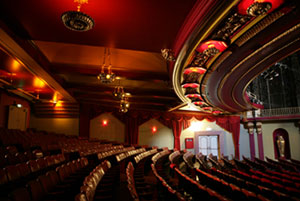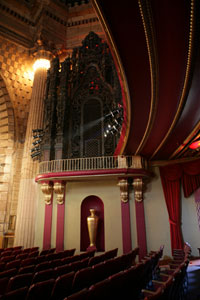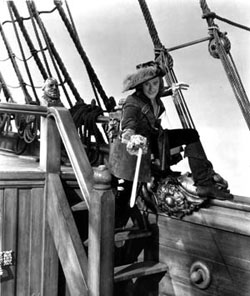A few weeks ago I attended a screening of Captain Blood (1935, directed by Michael Curtiz) at the Million Dollar Theater on Broadway in downtown Los Angeles, hosted by the Los Angeles Conservancy’s “Last Remaining Seats.” That series, now in its 25th year, has not only kept the memory alive of some of this city’s great movie palaces, but supported their survival by programming hundreds of classic films and live entertainment shows. The program has in fact brought more than 200,000 patrons to Broadway and Main Street theaters.

The Million Dollar Theater is of course one of the most storied cinema houses in Los Angeles. One of the first real movie palaces in the United States, the theater was also Sid Grauman’s first L.A. project, before he would go on to build the Egyptian and the Chinese in Hollywood. Sid, and his father David Grauman (who died in 1921), had built and operated several theaters in San Francisco before deciding to relocate to L.A. in 1917. Featuring seats for 2,345 patrons, the Million Dollar was designed by well-known L.A. architect Albert C. Martin, with Joseph Mora sculpting the exterior terra cotta figures and William Lee Woollett designing the elaborate interiors in a Spanish Baroque style with high key, dramatic lighting. The Million Dollar opened on February 1, 1918.

One of its major innovations was technical, the other curatorial. The program featured a live theatrical prologue, often themed with the main feature, thereby taking “Roxy” Rothafel’s New York movie palace showmanship one step further. Grauman decided to build the projection booth in the front and center of the balcony, rather than in the rafters, as was the case with other cinemas, because he hoped thereby to eliminate the keystone effect from projecting an image on a screen at a 45-degree angle. The short throw to the screen also allowed for much more light to hit the screen, since a significant amount of luminosity was lost in other cinemas on the trip down from the projection booth. The drawback in 1918 was, of course (apart from the loss of some seats), that they were projecting nitrate film from a miniscule booth, surrounded by movie patrons. Yikes! I suspect the fire marshal eventually nixed further theaters in that design.
Before the show began, the audience experienced an amazing treat. My longtime colleague from the Warner Bros. Corporate Archive, Leith Adams, came on stage and told the audience about seeing the original theatrical curtain from The Jazz Singer in the textile department at Warner Bros. back in the 1980s when he was still working at USC’s Warner Bros. Archives. He mentioned seeing it again over the years, then the curtain went up and behind it, hanging in its full splendor for the first time since 1927, was the actual deep wine red curtain from The Jazz Singer. The audience broke out in spontaneous applause, and it was truly a magical moment.

Captain Blood has been one of my favorite films since I was probably eight years old, because how couldn’t Errol Flynn not be my role model? I guess I saw that film, as well as The Adventures of Robin Hood (1938), Essex and Elisabeth (1939), and The Sea Hawk (1940), at least 20 times on television before I knew even what a film buff was, but seeing the film in a big theatre is an amazing experience. What surprised me most, however, was that Captain Blood, made two years after Hitler came to power, can be very easily read as an anti-Nazi parable. Not only is Dr. Blood falsely accused and sent into slavery for life without due process, Blood’s work camp on the island, with its high walls, guard towers, and barracks looks just like a Nazi concentration camp. Given that a Warner Bros. district manager, Joe Brandt, was beaten to death on the street in Berlin in 1934 by Stormtroopers, this does not seem far-fetched.






 Mobile Navigation
Mobile Navigation

